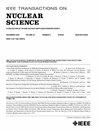Modeling the Radiation-Induced Attenuation Limits in Optical Fibers During Concurrent Irradiation, Thermal Annealing, and Photobleaching
IF 1.9
3区 工程技术
Q3 ENGINEERING, ELECTRICAL & ELECTRONIC
引用次数: 0
Abstract
The radiation-induced attenuations (RIAs) observed in optical fibers can be understood in terms of charge transfer and trapping rates using simple zero-field kinetic models. Herein, we analytically evaluate a one trap one recombination center (OTOR) kinetic model, wherein the primary trap state is actively thermally and/or optically bleached during the period of irradiation. Considering only the equilibrated system, we derive equations that describe the saturated trap concentrations in terms of the important experimental inputs: the radiation dose rate, the temperature, and the optical power. The equations are then reformulated in terms of saturation RIA values. Various optical fiber RIA data are extracted from the literature, wherein the aforementioned experimental inputs were varied. The derived equations describe these data with high fidelity in terms of the experimentally determined radiation dose rates, temperatures, and optical powers. Thus, we demonstrate a method through which high dose RIA values can be understood, modeled, and predicted under different experimental irradiation and bleaching conditions.模拟光纤在同步辐照、热退火和光漂白过程中的辐射诱导衰减极限
在光纤中观察到的辐射诱导衰减(RIAs)可以用简单的零场动力学模型来理解电荷转移和捕获速率。在这里,我们分析地评估了一个一个陷阱一个重组中心(OTOR)动力学模型,其中主要的陷阱状态是在辐照期间积极的热和/或光学漂白。仅考虑平衡系统,我们推导了描述饱和阱浓度的方程,该方程根据重要的实验输入:辐射剂量率、温度和光功率。然后根据饱和RIA值重新制定方程。从文献中提取了各种光纤RIA数据,其中上述实验输入是不同的。导出的方程以实验确定的辐射剂量率、温度和光功率的高保真度描述了这些数据。因此,我们展示了一种在不同实验辐照和漂白条件下可以理解、建模和预测高剂量RIA值的方法。
本文章由计算机程序翻译,如有差异,请以英文原文为准。
求助全文
约1分钟内获得全文
求助全文
来源期刊

IEEE Transactions on Nuclear Science
工程技术-工程:电子与电气
CiteScore
3.70
自引率
27.80%
发文量
314
审稿时长
6.2 months
期刊介绍:
The IEEE Transactions on Nuclear Science is a publication of the IEEE Nuclear and Plasma Sciences Society. It is viewed as the primary source of technical information in many of the areas it covers. As judged by JCR impact factor, TNS consistently ranks in the top five journals in the category of Nuclear Science & Technology. It has one of the higher immediacy indices, indicating that the information it publishes is viewed as timely, and has a relatively long citation half-life, indicating that the published information also is viewed as valuable for a number of years.
The IEEE Transactions on Nuclear Science is published bimonthly. Its scope includes all aspects of the theory and application of nuclear science and engineering. It focuses on instrumentation for the detection and measurement of ionizing radiation; particle accelerators and their controls; nuclear medicine and its application; effects of radiation on materials, components, and systems; reactor instrumentation and controls; and measurement of radiation in space.
 求助内容:
求助内容: 应助结果提醒方式:
应助结果提醒方式:


